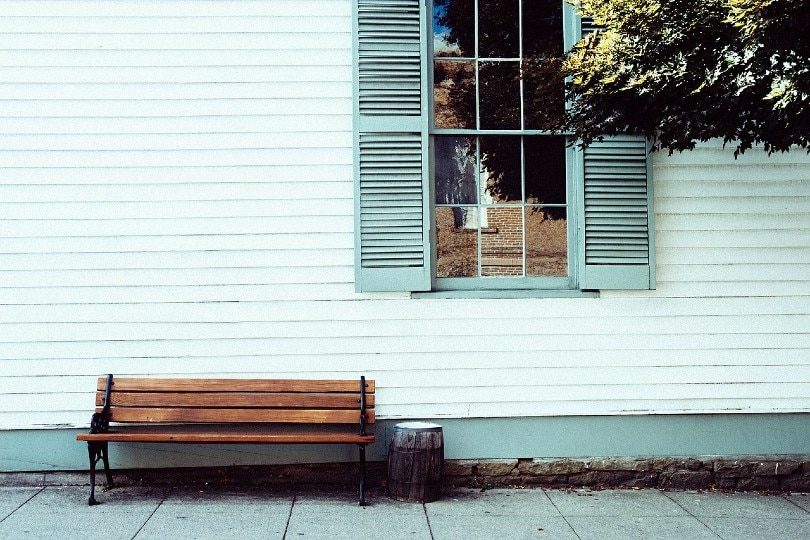Can You Paint Siding On a House? What Siding Can You Paint?
-
Pete Ortiz
- Last updated:

Taking care of your home’s appearance is near the top of any homeowner’s to-do list, and one that frequently gets overwhelming. There never seems to be enough time in the day to get everything done. For example, the siding on your home can give either a great first impression or a very poor one.
The best way to freshen and revitalize your home’s exterior is to give your siding a fresh coat of paint or two, but not everyone is a siding expert—we assume that’s why you’re here. What types of siding exist, and can you even paint them all the same? Let’s check out the different types of siding available, and what paint options are available for each of them.
 Types of Siding & Paint Options
Types of Siding & Paint Options
Wood Siding
Wood is an environmentally friendly and customizable siding material, but the downside is that wood requires more maintenance than other materials. Wood is an attractive siding choice, and it doesn’t pollute the planet as much as other types of siding.
A lot of wood siding sold today is pre-painted to protect it against the elements, but you can paint over it yourself if the color isn’t right for your home. Oil paints are a common choice for wood siding, but acrylic latex variants may offer greater longevity and durability.
Your average wood siding needs to be repainted or re-stained about every 5 years, but some varieties can go as long as 7 years. If you live in an area with lots of harsh weather or temperature fluctuations, your siding will shrink, expand, and possibly crack. These can make the paint peel, flake, or crack on your siding.

Vinyl Siding
Vinyl siding continues to be a popular choice among homeowners seeking cheap and long-lasting siding. Vinyl comes in a huge array of colors and textures, so you won’t need to slap a fresh coat on brand-new vinyl. Simply look for the style that fits your home’s exterior and forget about it.
Vinyl is known for being very low-maintenance, especially compared to wood. Vinyl can be painted in the event that the siding gets worn or damaged from the sun, snow, rain, and other inclement weather. Thrifty folks with extra paint lying around can certainly touch up worn vinyl siding and save a few bucks instead of replacing the worn portions, but that undermines vinyl’s convenience factor.
In the event that you decide to paint your vinyl siding, we would recommend 100% acrylic paint. Acrylic can be easily applied to existing siding, and although dark colors will bubble in harsh sunlight, it will last for several years before reapplication.
Aluminum Siding
Aluminum is a great alternative to wood or vinyl siding that offers unique advantages. Unlike wood, aluminum doesn’t rot in high moisture conditions, and unlike vinyl, it doesn’t become brittle at very low temperatures. The best benefit of aluminum siding is that it’s better than either wood or vinyl insulation, making it ideal for cold climates.
The tradeoff is that aluminum is more prone to scratches or dents than those other siding types. Also worth mentioning is that aluminum usually comes pre-painted, so you shouldn’t have to paint it for at least a couple of years.
After that, you’ll notice the paint becoming chalky and the underlying metal sheen will become visible. It’s far, far cheaper to give it a fresh coat of paint than to repaint it, plus there are lots of color choices available.
The trick to repainting aluminum siding is choosing the right type of paint. Acrylic latex tends to adhere the best, and you’ll want to stay away from glossy finishes that can highlight any dents in your siding. Instead, opt for paints with a matte or satin finish that match your existing siding as closely as possible.
Siding Breakdown
| Wood | Vinyl | Aluminum | |
| Pros | Eco-friendly, quick installation | Long-lasting, requires little maintenance, inexpensive | Great insulator, doesn’t rot or crack |
| Cons | Rots, warps, cracks, requires maintenance | Cracks at low temps, can lower home value | Can become dented or scratched easily |
| Best Paint | Acrylic latex (or oil) | Acrylic | Acrylic latex |
Featured Image Credit: kissu, Pixabay
Contents

 Types of Siding & Paint Options
Types of Siding & Paint Options